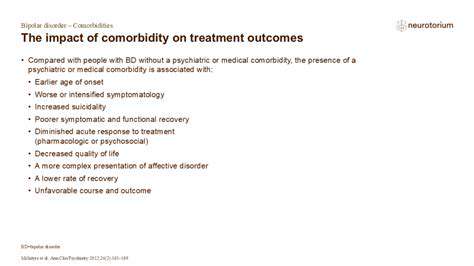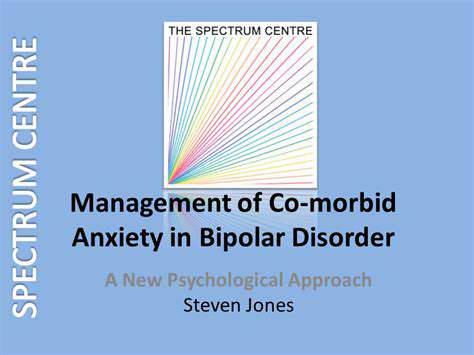Understanding Comorbid Anxiety Conditions
The Impact of Comorbidity on Treatment and Outcomes

The Definition of Comorbidity
Comorbidity refers to the presence of two or more medical conditions or diagnoses in a single individual. This often complicates treatment plans and necessitates a more comprehensive approach to care. Understanding the interplay between these conditions is crucial for effective management and positive patient outcomes. A thorough assessment of each condition, including its severity and potential impact on the other, is essential.
It's important to differentiate comorbidity from simple co-occurrence. While co-occurrence simply means two conditions exist together, comorbidity implies a significant relationship between the conditions, often involving shared risk factors, pathophysiological mechanisms, or treatment interactions. This distinction is critical for tailoring appropriate interventions.
Impact on Treatment Planning
The presence of comorbidity significantly impacts treatment planning. Caregivers must consider the potential interactions and implications of each condition when designing an effective treatment strategy. This includes considering potential drug interactions, overlapping symptoms, and the need for adjustments to dosage or frequency.
A holistic approach to treatment is necessary, focusing not only on the individual conditions but also on the impact they have on each other and on the patient's overall well-being. This requires meticulous coordination and communication among healthcare professionals involved in the patient's care.
Treatment Response Variability
Patients with comorbid conditions often exhibit variable responses to treatment. Factors such as the severity of each condition, the presence of underlying risk factors, and the patient's overall health status can influence the effectiveness of interventions.
Predicting treatment outcomes in individuals with comorbidity can be challenging. The complex interplay of multiple conditions can lead to unpredictable responses, requiring ongoing monitoring and adjustments to the treatment plan.
Increased Healthcare Costs
Managing patients with comorbidity often leads to increased healthcare costs. This is due to the need for more frequent appointments, specialized diagnostic tests, and potentially more intensive treatment regimens. The costs can be substantial, impacting both individual patients and the healthcare system as a whole.
Potential for Adverse Events
Patients with comorbidity are at a higher risk of experiencing adverse events during treatment. This is because of the increased potential for drug interactions, adverse reactions to medications, and the complex interplay of different conditions.
Careful consideration of potential risks and benefits is essential when selecting treatments for patients with comorbidity. A thorough risk assessment and proactive monitoring are crucial to mitigate the likelihood of adverse events and ensure patient safety.
Long-Term Management Challenges
Long-term management of patients with comorbidity presents unique challenges. The complex nature of the conditions often requires a multidisciplinary approach involving various healthcare professionals, including physicians, nurses, therapists, and social workers. Coordinating care and ensuring continuity of support across different healthcare settings is vital.
The need for ongoing monitoring, adjustments to treatment plans, and proactive management of potential complications necessitates a strong patient-centered approach to ensure optimal health outcomes. This includes empowering patients with knowledge and tools to actively participate in their own care.
Strategies for Effective Management of Comorbid Anxiety

Prioritizing Tasks and Setting Realistic Goals
Effective management hinges on the ability to prioritize tasks and set realistic goals. This involves understanding project timelines, identifying critical tasks, and assigning appropriate resources. Prioritizing tasks based on urgency and importance is crucial for maximizing productivity and minimizing wasted effort. A well-defined project scope, including specific deliverables and timelines, allows for a clear understanding of expectations and ensures that everyone involved is working towards the same objectives. This meticulous planning process not only streamlines workflows but also fosters a sense of accountability among team members.
Setting realistic goals is equally important. Goals should be specific, measurable, achievable, relevant, and time-bound (SMART). Unrealistic expectations can lead to frustration and decreased motivation. Instead, focus on manageable milestones that contribute to the overall project objectives. This approach ensures that progress is consistently tracked and any potential roadblocks can be addressed proactively. By focusing on achievable goals, team members experience a sense of accomplishment and are more likely to remain engaged and motivated throughout the project. Regular check-ins and progress reports are vital for staying on track and adjusting strategies as needed.
Delegation and Effective Communication
Delegation is a cornerstone of effective management. It involves assigning tasks to team members based on their skills and expertise, thereby leveraging individual strengths and fostering a sense of ownership. This not only distributes workload but also empowers team members, allowing them to develop new skills and contribute meaningfully to the project's success. Careful consideration of individual capabilities is essential to ensure that tasks are delegated effectively and efficiently. This careful allocation of responsibilities promotes a collaborative environment and strengthens team dynamics.
Open and transparent communication is paramount. Regular team meetings, clear communication channels, and timely feedback are essential for keeping everyone informed and aligned. Open communication channels facilitate prompt issue resolution and prevent misunderstandings that can negatively impact project timelines and overall performance. Honest and constructive feedback, delivered thoughtfully and respectfully, encourages growth and fosters a culture of continuous improvement. Regular updates and progress reports, shared promptly and transparently, keep everyone informed and help mitigate potential conflicts early on.
Effective communication also involves actively listening to team members' concerns and ideas. Creating a safe space for open dialogue encourages collaboration and innovation. By actively listening to team concerns and offering opportunities for input, managers can build trust and foster a more engaged and motivated team. This fosters a sense of belonging and empowers team members to contribute their unique perspectives, ultimately leading to more innovative solutions and a more successful outcome.